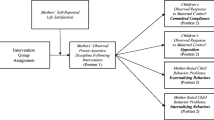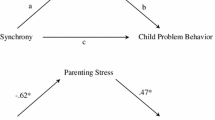Abstract
Fluctuations in parenting behaviour are thought to be important for the development of child psychopathology. This study focusses on fluctuations in the parenting behaviour of mothers with 3–6-year-old children with a clinical diagnosis according to the International Statistical Classification of Diseases and Related Health Problems 10th Revision (ICD-10) (N = 39) and compared them with a control group of mothers with children without a clinical diagnosis (N = 41). In a laboratory setting, we compared the quality of mother–child interactions between both groups using three increasingly challenging co-operation tasks. At first, the mother and child interacted via a free play task. They then co-operated within a constructional play task and finally within a challenging problem-solving task. We analysed the mothers’ parenting behaviour using the Laboratory Parenting Assessment Battery (LAB-PAB) and children’s problem behaviours by means of their mothers’ rating using the Child Behavior Checklist 1 ½–5 (CBCL). The results corroborated our hypotheses. Mothers of the group of children with clinical diagnoses had a lower parenting quality and higher fluctuations in parenting behaviour across situations compared with the non-clinical group. Further analysis revealed that specific fluctuations in maternal involvement and hostility uniquely predicted child psychopathology, measured with the CBCL, showing incremental validity of fluctuations in maternal involvement, when controlling for parenting quality and maternal difficulties in emotion regulation, measured with the Difficulties in Emotional Regulation scale. The results are discussed in terms of their implications for clinical interventions, as well as theoretical implications and future research.
Similar content being viewed by others
References
Campbell SB, Shaw DS, Gilliom M (2000) Early externalizing behavior problems: toddlers and preschoolers at risk for later maladjustment. Dev Psychopathol 12(3):467–488
Johnston C, Mash EJ (2001) Families of children with attention-deficit/hyperactivity disorder: review and recommendations for future research. Clin Child Fam Psychol Rev 4(3):183–207
Goodman SH, Rouse MH, Connell AM, Broth MR, Hall CM, Heyward D (2011) Maternal depression and child psychopathology: a meta-analytic review. Clin Child Fam Psychol Rev 14(1):1–27
Holodynski M, Friedlmeier W (2006) Development of emotions and emotion regulation, vol 8. Springer Science & Business Media, New York
Cummings EM, Valentino K (2015) Developmental psychopathology. Handbook of child psychology and developmental science, pp. 1–41
Martel MM (2009) Research review: a new perspective on attention-deficit/hyperactivity disorder: emotion dysregulation and trait models. J Child Psychol Psychiatry 50(9):1042–1051
Reyno SM, McGrath PJ (2006) Predictors of parent training efficacy for child externalizing behavior problems–a meta-analytic review. J Child Psychol Psychiatry 47(1):99–111
Shoda Y, Mischel W, Wright JC (1994) Intraindividual stability in the organization and patterning of behavior: incorporating psychological situations into the idiographic analysis of personality. J Pers Soc Psychol 67(4):674
Ainsworth MDS, Blehar MC, Waters E, Wall SN (2015) Patterns of attachment: a psychological study of the strange situation. Psychology Press, London
Cassidy J, Berlin LJ (1994) The insecure/ambivalent pattern of attachment: theory and research. Child Dev 65(4):971–991
Ainsworth MS (1979) Infant–mother attachment. Am Psychol 34(10):932
Pauli-Pott U (2008) Mothers with depressive symptoms: cross-situational consistency and temporal stability of their parenting behavior. Infant Behav Dev 31(4):679–687
Bolger N, Davis A, Rafaeli E (2003) Diary methods: capturing life as it is lived. Annu Rev Psychol 54(1):579–616
Seifer R, Sameroff AJ, Anagnostopolou R, Elias PK (1992) Mother-infant interaction during the first year: effects of situation, maternal mental illness, and demographic factors. Infant Behav Dev 15(4):405–426
Thompson SC, Cheek PR, Graham MA (1988) The other side of perceived control: Disadvantages and negative effects. In: Spacapan S, Oskamp S (eds) The claremont symposium on applied social psychology. The social psychology of health. Sage Publications, Inc, Thousand Oaks, CA, US, pp. 69–93
Lindhiem O, Bernard K, Dozier M (2011) Maternal sensitivity: within-person variability and the utility of multiple assessments. Child Maltreat 16(1):41–50
Gruber J, Kogan A, Quoidbach J, Mauss IB (2013) Happiness is best kept stable: positive emotion variability is associated with poorer psychological health. Emotion 13(1):1
Thompson RJ, Boden MT, Gotlib IH (2017) Emotional variability and clarity in depression and social anxiety. Cogn Emot 31(1):98–108
Crandall A, Deater-Deckard K, Riley AW (2015) Maternal emotion and cognitive control capacities and parenting: a conceptual framework. Dev Rev 36:105–126
Abidin RR (1992) The determinants of parenting behavior. J Clin Child Psychol 21(4):407–412
Marks DJ, Cyrulnik SE, Kera EC, Berwid OG, Santra A, Halperin JM (2006) Objective and subjective assessments of parenting in hyperactive preschoolers. Infant Child Dev 15(4):439–442
Dumas JE (1984) Interactional correlates of treatment outcome in behavioral parent training. J Consult Clin Psychol 52(6):946
Dumas JE, Wahler RG (1985) Indiscriminate mothering as a contextual factor in aggressive-oppositional child behavior:“Damned if you do and damned if you don’t”. J Abnorm Child Psychol 13(1):1–17
Madigan S, Plamondon A, Browne D, Jenkins J (2016) Stability of observed maternal behavior across tasks, time, and siblings. Parenting 16(2):108–124
Maas AJB, Vreeswijk CM, van Bakel HJ (2013) Effect of situation on mother–infant interaction. Infant Behav Dev 36(1):42–49
Dennis T (2006) Emotional self-regulation in preschoolers: the interplay of child approach reactivity, parenting, and control capacities. Dev Psychol 42(1):84
Robinson EA, Eyberg SM (1981) The dyadic parent–child interaction coding system: standardization and validation. J Consult Clin Psychol 49(2):245
Webster-Stratton C (1985) Dyadic parent–child interactive coding system-revised (DPICS-R): manual. Unpublished manuscript, University of Washington
Wilson S, Durbin CE (2012) The Laboratory Parenting Assessment Battery: development and preliminary validation of an observational parenting rating system. Psychol Assess 24(4):823
Achenbach TM, Rescorla LA (2000) Manual for the ASEBA preschool forms and profiles. University of Vermont, Research Center for Children, Youth, & Families, Burlington
Ram N, Gerstorf D (2009) Time-structured and net intraindividual variability: tools for examining the development of dynamic characteristics and processes. Psychol Aging 24(4):778
Ram N, Rabbitt P, Stollery B, Nesselroade JR (2005) Cognitive performance inconsistency: intraindividual change and variability. Psychol Aging 20(4):623–633. https://doi.org/10.1037/0882-7974.20.4.623
Nesselroade JR (2001) Intraindividual variability in development within and between individuals. Eur Psychol 6(3):187–193. https://doi.org/10.1027//1016-9040.6.3.187
Nesselroade JR, Salthouse TA (2004) Methodological and theoretical implications of intraindividual variability in perceptual-motor performance. J Gerontol Ser B: Psychol Sci Soc Sci 59(2):P49–P55
Estabrook R, Grimm KJ, Bowles RP (2012) A Monte Carlo simulation study of the reliability of intraindividual variability. Psychol Aging 27(3):560–576. https://doi.org/10.1037/a0026669
Gratz KL, Roemer L (2004) Multidimensional assessment of emotion regulation and dysregulation: development, factor structure, and initial validation of the difficulties in emotion regulation scale. J Psychopathol Behav Assess 26(1):41–54
Kendler KS, Sham P, MacLean C (1997) The determinants of parenting: an epidemiological, multi-informant, retrospective study. Psychol Med 27(3):549–563
Neitzel C, Dopkins Stright A (2004) Parenting behaviours during child problem solving: the roles of child temperament, mother education and personality, and the problem-solving context. Int J Behav Dev 28(2):166–179
Baram TZ, Davis EP, Obenaus A, Sandman CA, Small SL, Solodkin A, Stern H (2012) Fragmentation and unpredictability of early-life experience in mental disorders. Am J Psychiatry 169(9):907–915
Mischel W, Shoda Y (1995) A cognitive-affective system theory of personality: reconceptualizing situations, dispositions, dynamics, and invariance in personality structure. Psychol Rev 102(2):246
Thompson RA (1994) Emotion regulation: a theme in search of definition. Monogr Soc Res Child Dev 59(2–3):25–52
Cervone D (1985) Randomization tests to determine significance levels for microanalytic congruences between self-efficacy and behavior. Cognit Ther Res 9(4):357–365
Furr RM, Funder DC (2004) Situational similarity and behavioral consistency: subjective, objective, variable-centered, and person-centered approaches. J Res Pers 38(5):421–447
Repetti RL, Wood J (1997) Effects of daily stress at work on mothers’ interactions with preschoolers. J Fam Psychol 11(1):90
Sobol MP, Ashbourne DT, Earn BM, Cunningham CE (1989) Parents’ attributions for achieving compliance from attention-deficit-disordered children. J Abnorm Child Psychol 17(3):359–369
Patterson GR, Fisher PA (2002) Recent developments in our understanding of parenting: bidirectional effects, causal models, and the search for parsimony. Handb Parent 5:59–88
Patterson GR (1982) Coercive family process, vol 3. Castalia Publishing Company, Kouvola
Smith JD, Dishion TJ, Shaw DS, Wilson MN, Winter CC, Patterson GR (2014) Coercive family process and early-onset conduct problems from age 2 to school entry. Dev Psychopathol 26(4 Pt 1):917–932. https://doi.org/10.1017/S0954579414000169
Kazdin AE (2018) Implementation and evaluation of treatments for children and adolescents with conduct problems: findings, challenges, and future directions. Psychother Res 28(1):3–17. https://doi.org/10.1080/10503307.2016.1208374
Müller JM, Wagner K, Esins S, Romer G, Achtergarde S (2015) Das Play-PAB-Verfahren und seine Validierung an einer vorschulpsychiatrischen Inanspruchnahmepopulation/The Play-PAB and its Validation in a Preschool Psychiatric Population. Praxis der Kinderpsychologie und Kinderpsychiatrie 64(9):690–705
Morawska A, Basha A, Adamson M, Winter L (2015) Microanalytic coding versus global rating of maternal parenting behaviour. Early Child Dev Care 185(3):448–463
Möller EL, Nikolić M, Majdandžić M, Bögels SM (2016) Associations between maternal and paternal parenting behaviors, anxiety and its precursors in early childhood: a meta-analysis. Clin Psychol Rev 45:17–33
Amato PR, Rivera F (1999) Paternal involvement and children's behavior problems. J Marriage Fam 61(2):375–384
Pleck JH (2010) Paternal involvement. The role of the father in child development, p 58
Acknowledgements
We would like to thank Luisa Lampkemeyer, Lara Jegelka, and Mona Hillmann for the recruitment of the non-clinical group. Moreover, we thank the staff from the outpatient and day clinics of the Department of Child and Adolescent Psychiatry, Psychosomatics and Psychotherapy at the University Hospital of Münster.
Author information
Authors and Affiliations
Corresponding author
Ethics declarations
Conflict of interest
On behalf of all authors, the corresponding author states that there are no conflicts of interest.
Ethical standards
The study was approved by the Ethics Committee of the Medical Association of the Physicians Chamber Westfalen-Lippe. All mothers gave written consent and their children gave oral consent to participate in the study after a detailed explanation of the course of the study and data protection aspects. All participants got a 15 Euro voucher as an expense allowance.
Rights and permissions
About this article
Cite this article
Janßen, M., Holodynski, M., Müller, J.M. et al. Impaired predictability: enhanced fluctuations in the parenting behaviour of mothers of pre-school children with clinical diagnoses across three different play tasks. Eur Child Adolesc Psychiatry 28, 1645–1658 (2019). https://doi.org/10.1007/s00787-019-01330-8
Received:
Accepted:
Published:
Issue Date:
DOI: https://doi.org/10.1007/s00787-019-01330-8




